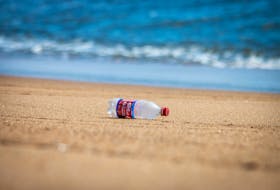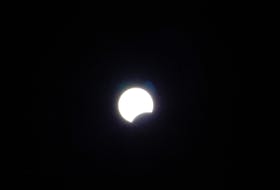The Atlantic Heron is a rather blocky-looking orange oilfield supply vessel you’d probably recognize if you are a regular visitor to the St. John’s waterfront.
It’s almost new, with a tall, square bow, built in 2017, and it’s 86 metres long. (The length is the important part, and we’ll get back to that in a moment.)
Wednesday, the Canada-Newfoundland and Labrador Offshore Petroleum Board (CNLOPB) shut down operations on the SeaRose FPSO, the production vessel that brings oil up from the White Rose oilfield and stores that oil onboard until it can be transshipped to tankers. Operations won’t resume until the board is satisfied with the company’s corrective actions.
The iceberg in question was estimated to be 40 metres wide, 60 metres long, and was moving toward the stationary FPSO, which, incidentally, had more than 340,000 barrels of crude oil on board.
The CNLOPB was concerned about something that happened last March: on March 28, 2017, an iceberg was charted as heading towards the FPSO. By early in the morning of March 29, it was heading almost directly for the FPSO.
The iceberg in question was estimated to be 40 metres wide, 60 metres long, and was moving toward the stationary FPSO, which, incidentally, had more than 340,000 barrels of crude oil on board.
The FPSO got ready to disconnect from the sea floor, but didn’t actually get clear; in fact, the crew were told to muster and to brace for impact.
The iceberg, which had been given the relatively-innocuous sounding name Iceberg 2017-11, came well within the ice zone where safety rules specifically required the rig to disconnect, and then kept coming. At its closest, before veering off, the iceberg was just 180 metres away from the FPSO.
Back now to the Atlantic Heron — if you’ve seen supply vessels, you can probably draw one up in your memory. The Heron, as we pointed out, is 86 metres long — meaning the iceberg was barely over two boat lengths away from the FPSO.
That’s not a close call. That’s an extremely close call.
And it was immediately clear that Husky Oil Operations had not been following the rules on how to deal with the encroaching iceberg.
“Husky did not follow that plan … namely, (to) disconnect the SeaRose FPSO and sail away from Iceberg 2017-11,” the Board said in a letter dated April 7, 2017.
By then, the CNLOPB had determined that the operators were in violation, and issued an order about the failure.
Ever since then, the board has been waiting for the operator’s final investigation report before taking action.
So why drag the Atlantic Heron into the equation?
Comparisons like that help to make crystal clear the gravity of the situation.
Here’s another comparison for you: the CNLOPB pointed out that the SeaRose, at the time of the incident, had 84 people on board.
The exact same number of people the Ocean Ranger had on board when it sank in 1982.
Ponder that.

![['The SeaRose FPSO and the White Rose field. — Submitted photo Husky Energy/Greg Locke © 2008. www.greglocke.com']](https://saltwire.imgix.net/searose-fpso-2552814.jpg?cs=srgb&fit=crop&h=568&w=847&dpr=1&auto=compress%2Cformat%2Cenhance)







